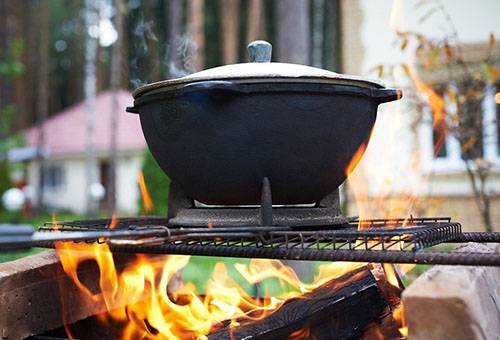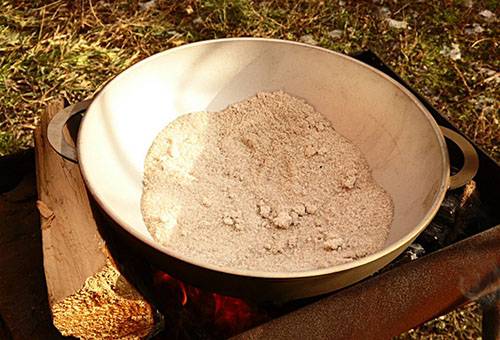What is the best way to calcinate a cauldron of cast iron or aluminum and is it necessary?
Pilaf, stewed meat - thought, and immediately drooling. Delicious! Of course, you can cook these culinary masterpieces in an ordinary pan. But in a specialized - cauldron - these dishes are obtained such that you just lick your fingers.
A cauldron is a pan with a rounded bottom. They are made of cast iron, aluminum, and other metal alloys. But the latter are extremely rare and are more often used to decorate the kitchen.
The new cauldron requires the attention of the hostess. Before the first cooking it needs to be calcined. Experienced chefs recommend buying an already experienced cauldron. So, they say, and the dishes are tastier, and you can skip the obligatory calcination procedure.
Why experiment with high temperatures? The fact is that metal products - of any kind - are cast in forms. To separate a cast-iron or aluminum cauldron or pan from the mold, it is covered with a layer of technical oil. As the hostess of the form when baking muffins. If you do not want to enjoy the taste and smell of machine grease instead of pilaf, then before 1 use, cookware must be calcined. This will remove any grease.
How to calcine a cast iron cauldron?
It sounds complicated, but the process is quite simple. The main thing is to comply with the rules and not to burn hands and other parts of the body, and also not to burn the kitchen.
There are several ways to ignite a cast iron cauldron.
- On an open flame.
New cast-iron dishes should be washed with warm water and detergent. Then warm the cauldron over an open fire for 2-3 hours. You can use a gas stove, but it is better to do this in the fresh air. When burning, engine oil emits corrosive smoke, so this method is best not to be used indoors.
The signal to the end of the process is the disappearance of dark spots from the surface of the cauldron.
- Over an open fire using rock salt. The method for the premises.
For a cast-iron cauldron, 2 to 3 kg of table salt will be required. Use coarse rock salt, extra will not work.
It will take 1 to 2 hours to warm the container over a fire with salt. The salt should turn evenly brown, as it will adsorb engine oil. It should be thrown away.
- Calcination with oil.
This operation is optional after dry calcination. The cast iron boiler has the property of rusting, so lubrication is still necessary.
Pour 1 liter of oil into the red-hot cauldron - olive, cotton, and sunflower. Wait until the oil boils, and gently tilt the container so that the liquid covers all the walls of the cauldron. Leave on fire for 2 hours.
If the dimensions of the oven allow, then it is possible to carry out calcination with oil in the oven at a temperature of 200 degrees for 2 hours.
After processing, leave the cauldron to cool. Do not pour water into it! Cast iron is a brittle material, and the dishes may crack. After complete cooling, wash the boiler with warm water and detergents.
How to calcine an aluminum cauldron?
Aluminum cauldron is a budget option. Such dishes cost less than their cast-iron counterparts, and they are much lighter. But the aluminum pans heat up quickly and cool quickly, so there will be no languishing effect, as in cast iron.
Aluminum is a low-melting metal, therefore, it is necessary to calcine such a cauldron with caution. Since there is a high probability of getting a metal lump instead of dishes.
Currently, aluminum cauldrons with non-stick coating have appeared on store shelves. Such dishes are not calcined before use!
The purpose of calcining an aluminum cauldron is to create a film of oxides on the surface. After that, free aluminum will not be able to get into food or chemically react with any ingredient.
- Open flame.
It is possible to calcine an aluminum cauldron on the street at the stake, like its cast-iron counterpart. But the fire should be below average. It is advisable to use raw firewood that does not give a high combustion temperature. The duration of the procedure is not more than 1.5 hours.
Aluminum utensils must be monitored during heat treatment. Otherwise, you risk not burning the boiler, but melting it!
- Use of table salt.
The principle of operation is the same as with cast-iron dishes. But - low fire, and the processing time is not more than 1.5 hours. The salt should turn creamy brown.
After calcination, salt cannot be used since it has absorbed engine oil.
- Use of vegetable oil or animal fat.
The procedure is the same as when annealing cast iron dishes. But aluminum cauldrons do not rust, since there is no iron in the alloy. Therefore, it makes no sense to play with oil! But if you want, then use oil to bake aluminum utensils.
The fire is below average, the processing time is 1.5 hours.
Tip
Be careful not to burn your hands and other parts of the body!
After annealing, leave the dishes alone until completely cooled. Aluminum does not burst due to temperature changes, like cast iron. But take the risk! Do not wash aluminum cauldrons with abrasive products or metal washcloths. You will damage the alumina layer. As a result, the dishes will start to burn, and harmful metal will enter the food.

